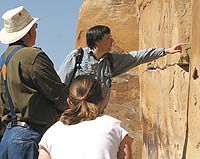| Edward Geary and Angela Paskett observe and listen to Troy Scotter of the Utah Rock Art Research Association. |
The Emery County Historical Society met May 30 at the Museum of the San Rafael. Joyce Staley introduced Troy Scotter who is a member of the Utah Rock Art Research Association as the guest presenter.
Staley informed the group of the newest published version of “Explore the Roads Less Traveled in the San Rafael Swell and the Scenic Heart of Castle Country. This publication provides self guided driving tours in the San Rafael, Utah and vicinity.” The special edition has a bench mark map inside and is available at the Museum of the San Rafael free of charge.
She then reminded the group that the book “Images of America the San Rafael Swell” is now in the second printing. This book contains a large number of photos from around Emery County. The response has been tremendous for this book which sells for $20 or 19.95 if you buy it from Staley at her home or at her office in the Old Court House. The proceeds of the book sales go to the Emery County Historical Society.
Scotter, from Provo, then presented a slide show of the Rochester Panel, the Head of Sinbad, the Lone Warrior and Black Dragon on the Barrier Reef in the San Rafael Swell. This slide show was in preparation for the Saturday trek to these places.
Scotter explained how many thousands of years old some of the rock art was estimated to be and the history of which Indian tribes were involved in making the rock art. He first became interested in rock art after camping out on BLM land near Goblin Valley one night. When he awoke in the morning he saw near his camp site a beautiful rock art panel. He described how the landscape in Utah changed over thousands of years from rich vegetation and rain after the glaciers receded in the North to the desert as we now know it.
He discussed the various Native Americans and the tools they used to survive. They went from growing crops to hunter and gatherer people. The horse allowed some to travel long distances to gather food and hides for clothing such as the buffalo. The Anasazi and Fremont Indians were discussed, also the Pueblo, Utes, Piutes, Arapahoe, Navajo, and the Apache.
| Troy Scotter explains the writings along the Moore cutoff road. |
The rock art found on the walls of canyons display the things they were familiar with. Some represent wars, some represent finding animals for food, some show snakes and some have rainbows. Many rock art displays have a large human figure which may represent their god.
The rock art in Nine Mile Canyon was discussed, and how the Utah Rock Art Research Association has been trying to preserve that area from oil and gas drilling. He also showed photos of vandalism of rock art, such as bullet holes and shot gun pellet holes. In some cases names have been written over the rock art. He was concerned that some citizens do not care enough to preserve these ancient art displays.
At 9 a.m., the following morning, the historical society met at the Moore Road to begin the trek to see the panels that were discussed at the dinner the preceding evening. Scotter led the adventurers to the Rochester Panel for the first stop.
Here, they donned their walking shoes for the half mile hike into the panel. At the panel, Scotter explained his interpretations of some of the images. He said all of the researchers do not always agree on what the images represent, but all agree they are worth preserving and protecting.
“This is the biggest site of its kind in the area. In the past, secrecy was our best line of defense to protect these sites from vandalism. But now, with the internet and GPS systems, everyone knows about and can locate all the sites very easily. We now must think differently about protecting and managing these sites,” said Scotter.
Scotter told the group that education about the ancients who made these drawings is the best line of defense in their protection. He said more signage is needed to inform visitors of the value of the irreplaceable sites. “Although everyone does not always agree on the meaning of the rock art, it is very important to protect our heritage and these sites,” stated Scotter.
The caravan proceeded on to the writings on the Moore cutoff road, after which they went to the Head of the Sinbad to view the Lone Warrior site and have lunch. Following the Sinbad Panel, the group then went to the Black Dragon. This trek took about 10 hours and all agreed it as well worth the trip.

